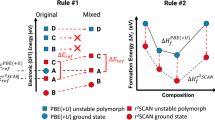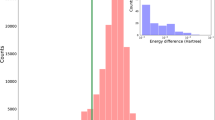Abstract
One atom or molecule binds to another through various types of bond, the strengths of which range from several meV to several eV. Although some computational methods can provide accurate descriptions of all bond types, those methods are not efficient enough for many studies (for example, large systems, ab initio molecular dynamics and high-throughput searches for functional materials). Here, we show that the recently developed non-empirical strongly constrained and appropriately normed (SCAN) meta-generalized gradient approximation (meta-GGA) within the density functional theory framework predicts accurate geometries and energies of diversely bonded molecules and materials (including covalent, metallic, ionic, hydrogen and van der Waals bonds). This represents a significant improvement at comparable efficiency over its predecessors, the GGAs that currently dominate materials computation. Often, SCAN matches or improves on the accuracy of a computationally expensive hybrid functional, at almost-GGA cost. SCAN is therefore expected to have a broad impact on chemistry and materials science.
This is a preview of subscription content, access via your institution
Access options
Subscribe to this journal
Receive 12 print issues and online access
$259.00 per year
only $21.58 per issue
Buy this article
- Purchase on Springer Link
- Instant access to full article PDF
Prices may be subject to local taxes which are calculated during checkout


Similar content being viewed by others
References
Kohn, W. & Sham, L. J. Self-consistent equations including exchange and correlation effects. Phys. Rev. 140, A1133–A1138 (1965).
Perdew, J. P. & Wang, Y. Accurate and simple analytic representation of the electron-gas correlation energy. Phys. Rev. B 45, 13244–13249 (1992).
Sun, J., Perdew, J. P. & Seidl, M. Correlation energy of the uniform electron gas from an interpolation between high-and low-density limits. Phys. Rev. B 81, 085123 (2010).
Perdew, J. P., Burke, K. & Ernzerhof, M. Generalized gradient approximation made simple. Phys. Rev. Lett. 77, 3865–3868 (1996).
Perdew, J. P. et al. Restoring the density-gradient expansion for exchange in solids and surfaces. Phys. Rev. Lett. 100, 136406 (2008).
Perdew, J. P., Burke, K. & Ernzerhof, M. Reply to the comment by Y. Zhang and W. Yang. Phys. Rev. Lett. 80, 891 (1998).
Perdew, J. P., Ruzsinszky, A., Sun, J. & Burke, K. Gedanken densities and exact constraints in density functional theory. J. Chem. Phys. 140, 18A533 (2014).
Sun, J., Perdew, J. P. & Ruzsinszky, A. Semilocal density functional obeying a strongly-tightened bound for exchange. Proc. Natl Acad. Sci. USA 112, 685–689 (2015).
Becke, A. D. & Rousssel, M. R. Exchange holes in inhomogeneous systems: a coordinate-space model. Phys. Rev. A 39, 3761–3767 (1989).
Tao, J., Perdew, J. P., Staroverov, V. N. & Scuseria, G. E. Climbing the density functional ladder: nonempirical meta-generalized gradient approximation designed for molecules and solids. Phys. Rev. Lett. 91, 146401 (2003).
Zhao, Y. & Truhlar, D. G. A new local density functional for main-group thermochemistry, transition metal bonding, thermochemical kinetics, and noncovalent interactions. J. Chem. Phys. 125, 194101 (2006).
Perdew, J. P., Ruzsinszky, A., Csonka, G. I., Constantin, L. A. & Sun, J. Workhorse semilocal density functional for condensed matter physics and quantum chemistry. Phys. Rev. Lett. 103, 026403 (2009).
Sun, J., Xiao, B. & Ruzsinszky, A. Effect of the orbital-overlap dependence in the meta-generalized gradient approximation. J. Chem. Phys. 137, 051101 (2012).
Del Campo, J. M., Gazquez, J. L., Trickey, S. B. & Vela, A. A new meta-GGA exchange functional based on an improved constraint-based GGA. Chem. Phys. Lett. 543, 179–183 (2012).
Sun, J., Ruzsinszky, A. & Perdew, J. P. Strongly constrained and appropriately normed semilocal density functional. Phys. Rev. Lett. 115, 036402 (2015).
Madsen, G. K. H., Ferrighi, L. & Hammer, B. Treatment of layered structures using a semilocal meta-GGA density functional. J. Phys. Chem. Lett. 1, 515–519 (2010).
Becke, A. D. & Edgecombe, K. E. A simple measure of electron localization in atomic and molecular systems. J. Chem. Phys. 92, 5397 (1990).
Silvi, B. & Savin, A. Classification of chemical bonds based on topological analysis of electron localization functions. Nature 371, 683–686 (1994).
Sun, J. et al. Density functionals that recognize covalent, metallic, and weak bonds. Phys. Rev. Lett. 111, 106401 (2013).
Perdew, J. P., Ernzerhof, M. & Burke, K. Rationale for mixing exact exchange with density functional approximations. J. Chem. Phys. 105, 9982–9985 (1996).
Furche, F. & Perdew, J. P. The performance of semilocal and hybrid density functionals in 3d transition-metal chemistry. J. Chem. Phys. 124, 044103 (2006).
Santra, B. et al. Hydrogen bonds and van der Waals forces in ice at ambient and high pressures. Phys. Rev. Lett. 107, 185701 (2011).
Tkatchenko, A. & Scheffler, M. Accurate molecular van der Waals interactions from ground state electron density and free atom reference data. Phys. Rev. Lett. 102, 073005 (2009).
Santra, B. et al. On the accuracy of van der Waals inclusive density-functional theory exchange-correlation functionals for ice at ambient and high pressures. J. Chem. Phys. 139, 154702 (2013).
Santra, B. et al. On the accuracy of density-functional theory exchange-correlation functionals for H bonds in small water clusters: the water hexamer. J. Chem. Phys. 129, 194111 (2008).
DiStasio, R. Jr, Santra, B., Li, Z., Wu, X. & Car, R. The individual and collective effects of exact exchange and dispersion interactions on the ab initio structure of liquid water. J. Chem. Phys. 141, 084502 (2014).
Perdew, J. P. & Zunger, A. Self-interaction correction to density-functional approximations for many-electron systems. Phys. Rev. B 23, 5048–5079 (1981).
Pederson, M. R., Ruzsinszky, A. & Perdew, J. P. Self-interaction correction with unitary invariance in density functional theory. J. Chem. Phys. 140, 121103 (2014).
Hennig, R. G. et al. Phase transformation in Si from semiconducting diamond to metallic β-Sn phase in QMC and DFT under hydrostatic and anisotropic stress. Phys. Rev. B 82, 014101 (2010).
Heyd, J., Scuseria, G. E. & Ernzerhof, M. Hybrid functionals based on a screened Coulomb potential. J. Chem. Phys. 118, 8207–8215 (2003).
Xiao, B. et al. Testing density functionals for structural phase transitions of solids under pressure: Si, SiO2 and Zr. Phys. Rev. B 88, 184103 (2013).
Batista, E. R. et al. Comparison of screened hybrid density functional theory to diffusion Monte Carlo in calculations of total energies of silicon phases and defects. Phys. Rev. B 74, 121102 (2006).
Sasaki, H., Tokizaki, E., Terashima, K. & Kimura, S. Density variation of molten silicon measured by an improved archimedian method. Jpn J. Appl. Phys. 33, 3803–3807 (1994).
Waseda, Y. et al. High temperature X-ray diffraction study of melt structure of silicon. Jpn J. Appl. Phys. 34, 4124–4128 (1995).
Cohen, R. E. Origin of ferroelectricity in perovskite oxides. Nature 358, 136–138 (1992).
Kitchaev, D. A. et al. Energetics of MnO2 polymorphs in density functional theory. Phys. Rev. B 93, 045132 (2016).
Bilc, D. I. et al. Hybrid exchange-correlation functional for accurate prediction of the electronic and structural properties of ferroelectric oxides. Phys. Rev. B 77, 165107 (2008).
Stroppa, A. & Picozzi, S. Hybrid functional study of proper and improper multiferroics. Phys. Chem. Chem. Phys. 12, 5405–5416 (2010).
Wu, Z. & Cohen, R. E. More accurate generalized gradient approximation for solids. Phys. Rev. B 73, 235116 (2006).
Neaton, J. B., Ederer, C., Waghmare, U. V., Spaldin, N. A. & Rabe, K. M. First-principles study of spontaneous polarization in multiferroic BiFeO3 . Phys. Rev. B 71, 014113 (2005).
Peng, H., Yang, Z., Sun, J. & Perdew, J. P. SCAN+rVV10: a promising van der Waals density functional. Preprint at https://arxiv.org/abs/1510.05712 (2015).
Frisch, M. J. et al. Gaussian 03 Revision D.02 (Gaussian, 2004).
Blum, V. et al. Ab initio molecular simulations with numeric atom-centered orbitals. Comp. Phys. Comm. 180, 2175–2196 (2009).
Kresse, G. & Joubert, D. From ultrasoft pseudopotentials to the projector augmented-wave method. Phys. Rev. B 59, 1758–1775 (1999).
King-Smith, R. D. & Vanderbilt, D. Theory of polarization of crystalline solids. Phys. Rev. B 47, 1651–1654 (1999).
Brandenburg, J. G., Maas, T. & Grimme, S. Benchmarking DFT and semiempirical methods on structures and lattice energies for ten ice polymorphs. J. Chem. Phys. 142, 124104 (2015).
Whalley, E. Energies of the phases of ice at zero temperature and pressure. J. Chem. Phys. 81, 4087–4092 (1984).
Xu, X. & Goddard, III, W. A. Bonding properties of the water dimer: a comparative study of density functional theories. J. Phys. Chem. A 108, 2305–2313 (2004).
Shank, A. et al. Accurate ab initio and ‘hybrid’ potential energy surfaces, intramolecular vibrational energies, and classical IR spectrum of the water dimer. J. Chem. Phys. 130, 144314 (2009).
Rocher-Casterline, B. E., Ch'ng, L. C., Mollner, A. K. & Reisler, H. Determination of the bond dissociation energy (D0) of the water dimer, (H2O)2, by velocity map imaging. J. Chem. Phys. 134, 211101 (2011).
Salek, P. et al. A comparison of density-functional-theory and coupled-cluster frequency-dependent polarizabilities and hyperpolarizabilities. Mol. Phys. 103, 439–450 (2005).
Lebeugle, D., Colson, D., Forget, A. & Viret, M. Very large spontaneous electric polarization in BiFeO3 single crystals at room temperature and its evolution under cycling fields. Appl. Phys. Lett. 91, 022907 (2007).
Acknowledgements
This research was supported as part of the Center for the Computational Design of Functional Layered Materials, an Energy Frontier Research Center funded by the US Department of Energy (DOE), Office of Science, Basic Energy Sciences (BES), under award no. DE-SC0012575. Computer equipment in Temple's HPC Center was supported by the National Science Foundation (NSF) under major research instrumentation grant no. CNS-09-58854. J.S., R.C.R., Y.Z., Z.S., A.R. and H.P. acknowledge support in the form of computer time from the National Energy Research Scientific Computing Center (NERSC), a DOE Office of Science User Facility, and the HPC Center of Temple University. X.W. and Y.Z. acknowledge support from the American Chemical Society Petroleum Research Fund (ACS PRF) under grant no. 53482-DNI6. J.S., A.R., X.W. and J.P.P. thank R. Car, G.I. Csonka, B. Santra and R. DiStasio Jr for discussions. This article is dedicated to the memory of Walter Kohn.
Author information
Authors and Affiliations
Contributions
J.S. and J.P.P. designed the project. J.S., R.C.R., Y.Z., Z.S., A.R. and H.P. carried out the calculations. J.S. implemented the SCAN metaGGA and prepared the initial manuscript. All authors contributed to the discussions and revisions of the manuscript.
Corresponding author
Ethics declarations
Competing interests
The authors declare no competing financial interests.
Supplementary information
Supplementary information
Supplementary information (PDF 362 kb)
Rights and permissions
About this article
Cite this article
Sun, J., Remsing, R., Zhang, Y. et al. Accurate first-principles structures and energies of diversely bonded systems from an efficient density functional. Nature Chem 8, 831–836 (2016). https://doi.org/10.1038/nchem.2535
Received:
Accepted:
Published:
Issue Date:
DOI: https://doi.org/10.1038/nchem.2535
This article is cited by
-
Defect passivation in methylammonium/bromine free inverted perovskite solar cells using charge-modulated molecular bonding
Nature Communications (2024)
-
Photothermal conversion mechanism of the dibenzotetrathiafulvalene-tetracyanobenzene cocrystal based on the transitions between the ground and excited states
Science China Materials (2024)
-
Terahertz-induced martensitic transformation in partially stabilized zirconia
Communications Physics (2023)
-
Recent advances and outstanding challenges for machine learning interatomic potentials
Nature Computational Science (2023)
-
Emergence of competing electronic states from non-integer nuclear charges
Communications Physics (2023)



